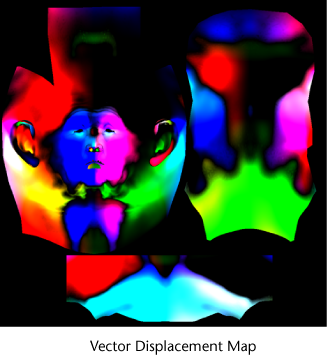A vector displacement map is a 2D image that records height and directional information for points on the model as 32 bit floating point color information. Vector displacement mapping allows a model to represent visual detail not modeled or sculpted into the original model and can be used as a method for transferring sculpted detail from one model to another.

Because vector displacement maps also contain directional information for the vertex displacements, they can faithfully record sculpted features that overhang or undercut other detail on the model.
Vector displacement maps can only be extracted between models that have identical vertex topology or one mesh must be identical to a subdivided level of the other. Vector displacement maps produce virtually artifact-free results when applied to the target mesh for rendering.
Vector displacement maps can be used to create images for stencils and stamps that can be used with the 3D sculpting tools.
Vector displacement maps are becoming increasingly supported in many production pipelines.